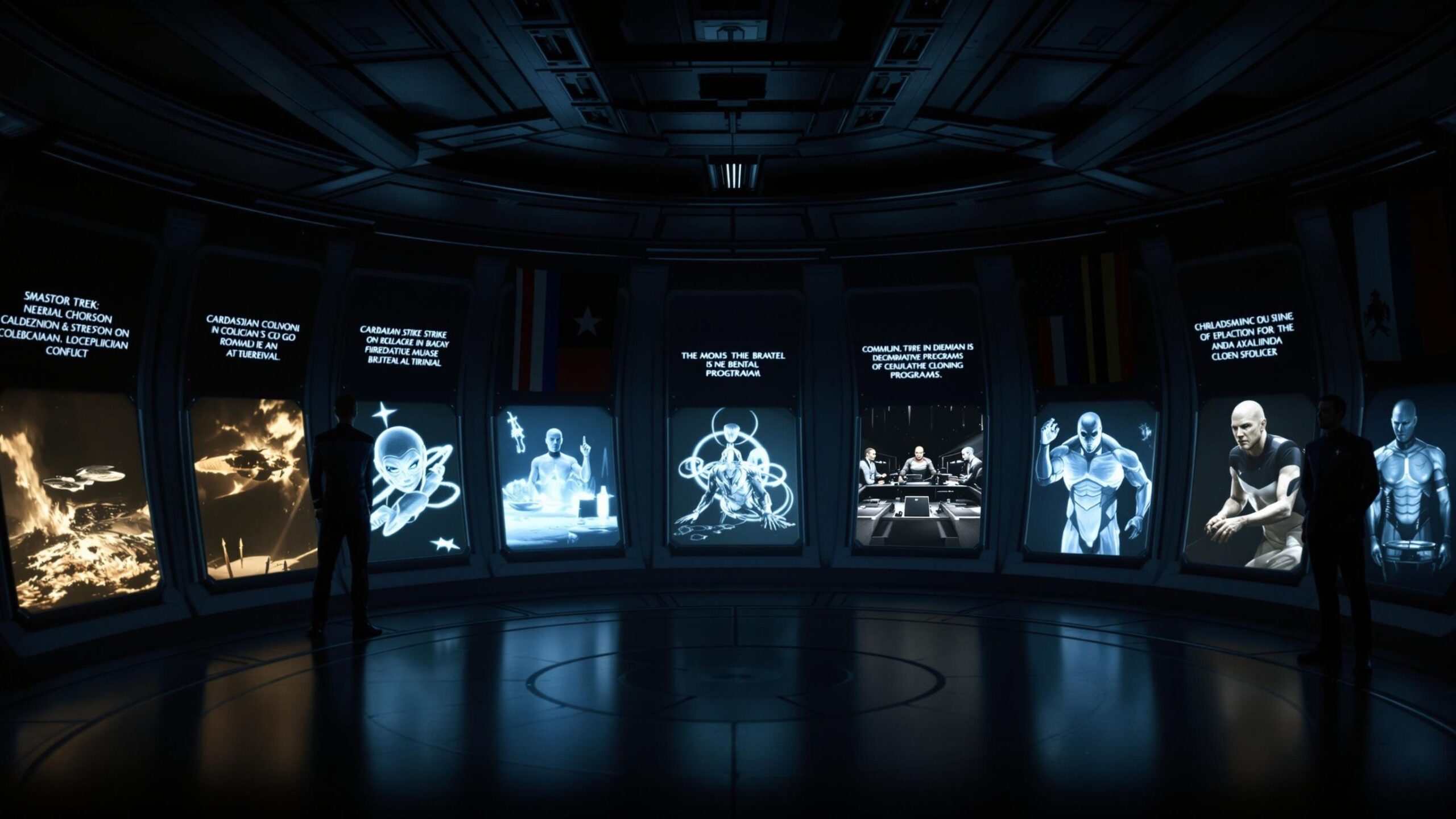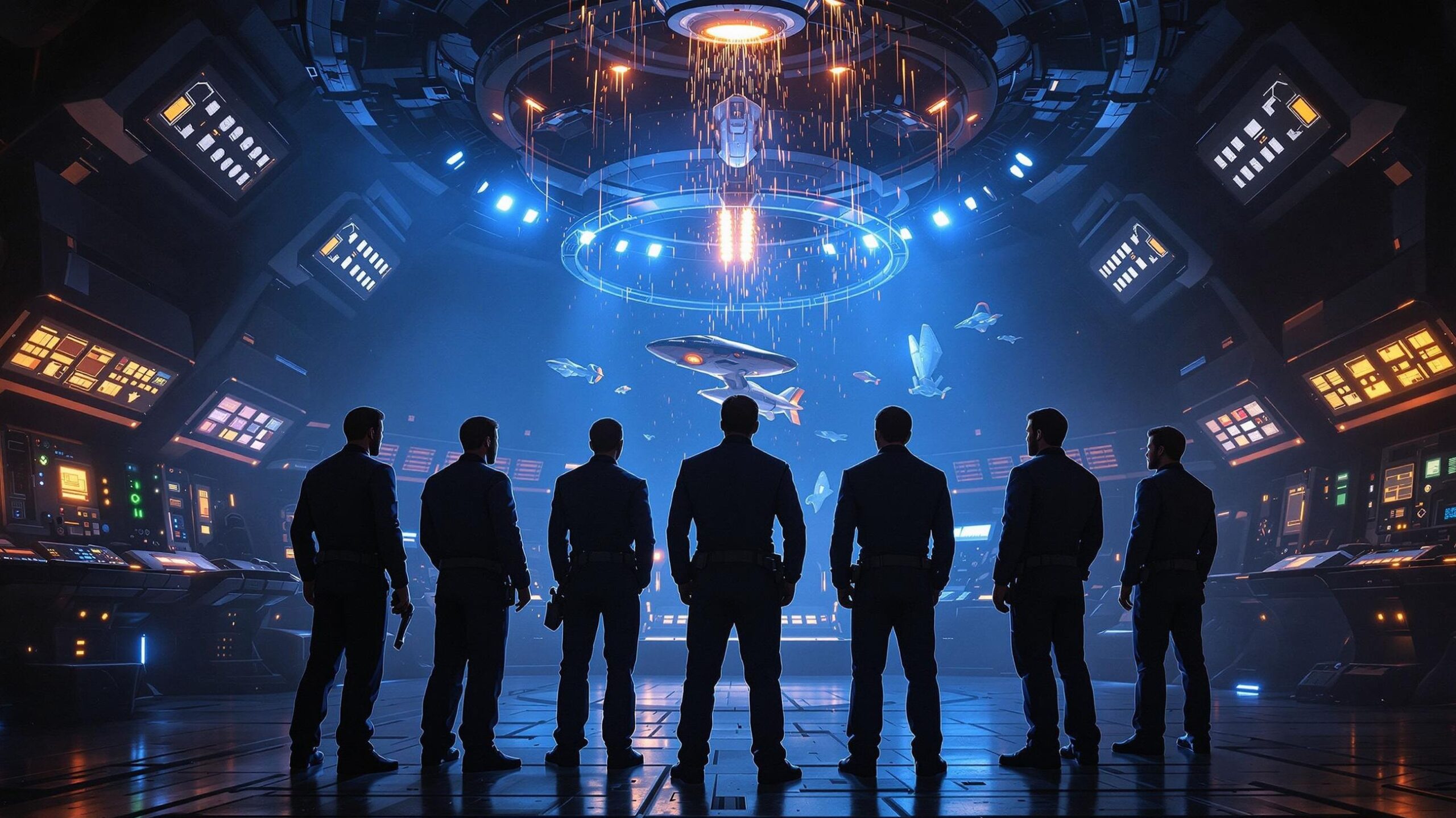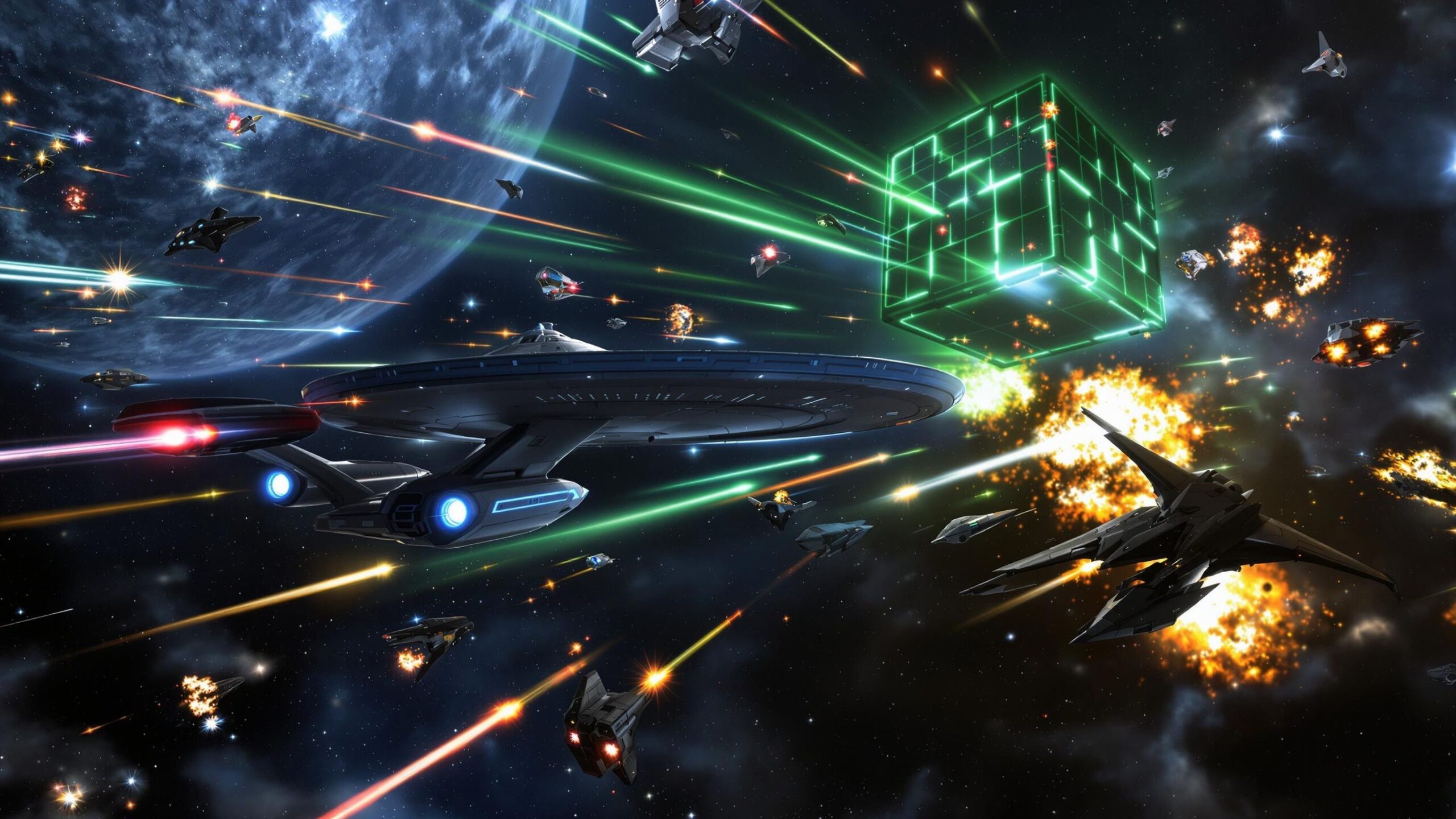Star Trek often portrays a utopian vision of the future, but its most gripping and morally complex stories arise when that vision is challenged—especially in times of war. Across centuries and series, the franchise has never shied away from exploring the darker side of galactic conflict. When diplomacy fails and desperation sets in, even the most principled civilizations have committed acts that, by any real-world measure, would be classified as war crimes. From mass genocide and biological experimentation to torture and forced relocation, these infamous acts ripple through history, forever staining the legacy of those involved. These are not just footnotes in Starfleet logs—they are warnings about how easily ideals can crumble in the face of fear, vengeance, or ambition. Here are the Top 10 Most Infamous War Crimes in Star Trek History, ranked by their impact, brutality, and the ethical scars they left behind.
#10: The Federation’s Forced Relocation of the Ba’ku – Star Trek: Insurrection
While presented as a diplomatic matter, the relocation of the Ba’ku people under the orders of the Federation and the Son’a is tantamount to a war crime. Under the guise of progress, the Federation planned to secretly displace the Ba’ku from their planet to gain access to its metaphasic radiation—a resource with immense healing properties. The Ba’ku, a peaceful community who had rejected advanced technology, would have been removed without their consent, their culture destroyed in the process. Captain Picard famously defied orders to stand against this decision, comparing it to historical forced relocations on Earth. The fact that such an operation was nearly carried out under Federation oversight reveals the dangerous hypocrisy that can arise even within the utopia of Starfleet. This incident highlights how easily noble institutions can justify immoral actions in pursuit of strategic advantage.
#9: Klingon Bombing of Praxis – Star Trek VI: The Undiscovered Country
While not a deliberate war crime against a sentient population, the Klingon Empire’s neglectful management and over-mining of Praxis—a moon vital to their energy infrastructure—led to an ecological catastrophe with galactic repercussions. The explosion devastated the moon, poisoned Kronos’s atmosphere, and sparked an urgent diplomatic crisis with the Federation. The recklessness displayed by the Klingon High Council, prioritizing military expansion over environmental safety, endangered countless lives and violated interstellar safety norms. The collapse of Praxis led to suffering not only within the Klingon Empire but throughout the quadrant, forcing rushed treaties and political upheaval. In war, negligence can be as devastating as active aggression, and Praxis remains a cautionary tale about imperial hubris and unsustainable militarism.
#8: Romulan Use of Thalaron Radiation – Star Trek: Nemesis
The use of thalaron radiation by Shinzon, a Reman clone of Captain Picard, represents one of the most horrifying and indiscriminate weapons ever seen in Star Trek. Thalaron particles are capable of rapidly petrifying organic matter, effectively turning living beings into ash within seconds. Shinzon’s plan to unleash this weapon on Earth would have resulted in mass genocide on an unprecedented scale. Though the Federation stopped the attack, the mere existence of such a weapon—developed and approved within Romulan intelligence—constitutes a clear violation of interstellar laws. Thalaron radiation is so grotesquely lethal that even possessing it is banned by most major powers. The weapon’s use in Nemesis, even in small-scale demonstrations, stands as a chilling reminder that weapons of mass destruction are never far from the shadows of diplomacy in Star Trek.
#7: The Cardassian Occupation of Bajor – Deep Space Nine
Few arcs in Star Trek are as emotionally powerful and politically charged as the Cardassian occupation of Bajor. Lasting over fifty years, the occupation was marked by labor camps, forced relocation, systematic torture, and the cultural destruction of the Bajoran people. Cardassian leaders like Gul Dukat oversaw operations that, in any real-world context, would qualify as ethnic cleansing. Thousands of Bajorans were killed or enslaved, their spiritual sites desecrated, and their natural resources stripped away. The occupation left deep psychological scars that would define Bajoran identity long after liberation. What makes this atrocity especially complex is the presence of characters like Dukat, who sees himself as a “benevolent” ruler—a chilling study in the banality of evil. The occupation’s legacy reverberates through every season of Deep Space Nine, showcasing the trauma, resistance, and moral ambiguities left in its wake.
#6: Federation’s Genesis Device – Star Trek II: The Wrath of Khan
On the surface, the Genesis Device was a scientific marvel—capable of transforming lifeless planets into habitable worlds in mere minutes. But as Dr. Carol Marcus herself warned, in the wrong hands, it could become the most terrifying weapon of mass destruction in the galaxy. The Federation’s willingness to develop such a device, with the potential to erase all existing life in its target area, flirts dangerously with the ethics of bioterrorism. When Khan uses it in The Wrath of Khan, the full destructive power of Genesis becomes terrifyingly clear. Though the Federation never sanctioned its use as a weapon, the fact that it existed at all—and was left vulnerable to hijack—raises questions about the Federation’s scientific oversight and willingness to gamble with extinction-level tools. Genesis was a war crime waiting to happen, and its creation alone stands as a damning indictment of unchecked ambition.
#5: Section 31’s Attempted Genocide of the Founders – Deep Space Nine
Perhaps no act in Star Trek is as morally horrifying—and bureaucratically chilling—as Section 31’s covert plan to wipe out the Founders, the shapeshifting leaders of the Dominion. Without oversight or authorization, the clandestine organization engineered a biological virus known as the morphogenic virus and infected Odo, knowing he would unintentionally transmit it to the entire Founder race. This was not an act of battlefield desperation—it was a long-term, calculated genocide carried out in secret under the banner of “defense.” What makes this war crime so infamous is its cold precision. Section 31 didn’t bomb cities or attack ships—they used medical knowledge as a weapon and concealed the entire operation from Starfleet Command. Even Dr. Bashir, upon discovering the plan, is horrified by the moral collapse it represents. The attempted genocide of an entire species, justified by the need for “peace,” is one of the darkest moments in the franchise and a terrifying commentary on what lies beneath even the most utopian societies.
#4: Dominion’s Use of Jem’Hadar as Disposable Soldiers – Deep Space Nine
The Dominion’s treatment of the Jem’Hadar—genetically engineered soldiers addicted to the drug Ketracel-white—is nothing short of systematic abuse and mass exploitation. Grown to serve, indoctrinated to obey, and designed to be utterly dependent on their masters, the Jem’Hadar are a tragic example of a species bred solely for warfare. They have no families, no futures, and no say in their lives. The Founders and their Vorta administrators see them as tools, not beings. In war, they’re deployed like pawns—sacrificed in droves to wear down enemies. Their lives are short, brutal, and controlled by chemical shackles. This kind of biological slavery violates every standard of sentient rights in the galaxy. It’s not just a war crime—it’s an institutionalized atrocity. That a few Jem’Hadar occasionally question their purpose makes them plight all the more haunting. They were bred for victory but never allowed to live beyond it.
#3: Klingon Massacre of Khitomer – The Next Generation
The Khitomer massacre is one of the bloodiest and most infamous events in Klingon history. The colony, which had long been a symbol of cooperation between the Federation and the Klingon Empire, was attacked by Klingon forces who viewed the alliance as a betrayal. The massacre resulted in the deaths of hundreds of civilians, including many families. It also served as a defining trauma in the life of Worf, the first Klingon raised by humans, whose parents were killed during the attack. The brutality of the assault, combined with the political ramifications it created, shook the fragile peace between the two powers and set the stage for generations of mistrust. The betrayal of one’s own people and the slaughter of innocents branded Khitomer as a war crime etched in both Klingon and Federation history. Though some Klingons would later attempt to justify it as a strategic necessity, history remembers it as an act of merciless bloodshed.
#2: The Destruction of the Xindi Homeworld (Alternate Timeline) – Enterprise
In the alternate future seen in the Enterprise episode “Twilight,” the Xindi succeed in destroying Earth with their superweapon, exterminating over seven billion people. In retaliation, the remaining forces of humanity, led by a desperate and traumatized Captain Archer, wage a brutal campaign that ultimately results in the extinction of the Xindi species. Though this future is erased by the end of the episode, the hypothetical genocide carried out by Starfleet forces raises harrowing ethical questions. It shows that even humanity, when cornered and broken, can commit atrocities in the name of justice or survival. The mere existence of this timeline—and its chilling plausibility—offers a sobering reminder that no species is immune to the temptations of vengeance and annihilation. It’s a what-if that lingers, reminding us how easily trauma can mutate into atrocity.
#1: The Federation’s Betrayal at AR-558 – Deep Space Nine
One of the most haunting portrayals of war in Star Trek is the siege at AR-558, where Starfleet soldiers are left to defend a critical communications outpost under horrific conditions. What begins as a tactical necessity becomes a slow, grinding descent into moral and psychological collapse. The Federation leaves troops on the planet far beyond standard rotation—some over 150 days—resulting in massive casualties, desperation, and even war crimes committed by otherwise honorable people. Quark, who visits the outpost with Nog, calls out the Federation’s hypocrisy, warning that humans are only “noble and kind” when they have comfort. The way the soldiers become hardened, broken, and at times violent, shows how war dehumanizes everyone it touches. AR-558 isn’t infamous because of a single crime—it’s infamous because of what it reveals: that in war, even the Federation will abandon its ideals, and in doing so, it risks becoming what it claims to oppose.
From biological genocide to the manipulation of sentient beings as disposable weapons, the Star Trek universe has never flinched from depicting the moral horror of war. These infamous acts weren’t just battlefield strategies—they were violations of life, dignity, and ethics. In some cases, the perpetrators believed they were protecting their way of life. In others, they simply didn’t care. What unites all these war crimes is their chilling reminder that even in a galaxy striving for peace and justice, darkness still lingers. And if we forget the past—if we let fear, vengeance, or pragmatism guide us—we risk repeating these atrocities again.




